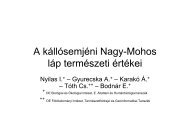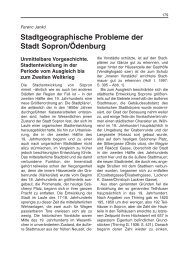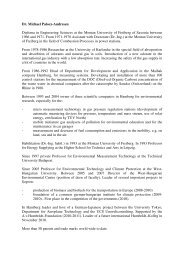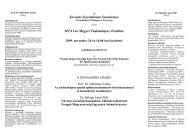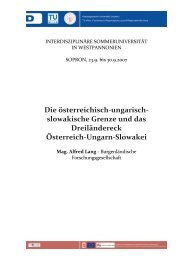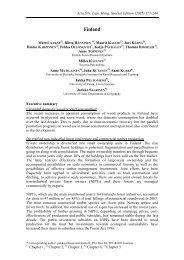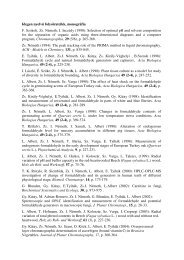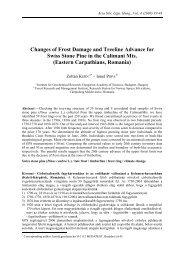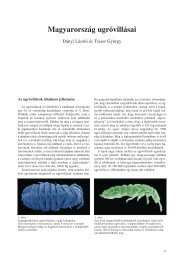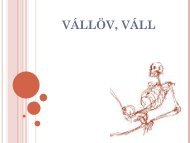PEDRON, Luca - PIVA, Giovanna - LA PORTA, Nicola
PEDRON, Luca - PIVA, Giovanna - LA PORTA, Nicola
PEDRON, Luca - PIVA, Giovanna - LA PORTA, Nicola
Create successful ePaper yourself
Turn your PDF publications into a flip-book with our unique Google optimized e-Paper software.
166<br />
Acta Silv. Lign. Hung. Spec. Edition, 2007<br />
Pedron, L. – Piva, G. – La Porta, N.<br />
among the Italian strains even without the small minor differences showed by RAPDs. These<br />
results between the two markers types are similar with those obtained by other authors<br />
(Santini – Capretti 2000, Bhattacharya – Ranade 2001, Sabir 2006).<br />
However, the high degree of similarity in S. cardinale is coherent with the common<br />
source of introduced isolates in Europe from the American continent about 60 years ago and<br />
suggest an occurring of a strong genetic bottleneck event.<br />
Considering the number of samples analysed, this study suggests that S. cardinale is very<br />
homogeneous if not even para-clonal population, having the almost the same genotype in the<br />
whole of Italy and probably also throughout Europe. The pathogen, that for the first time was<br />
isolate in California in the 1928 (Wagener 1939), was probably introduced in Europe and in<br />
Italy from USA (Graniti 1998).<br />
The finding that also the isolate from Greece didn’t show any significant difference with<br />
the Italian populations is emblematic of the high level of genetical homogeneity of this fungus<br />
at least in Europe. This situation is even more evident in S. cardinale, because, at present, the<br />
sexual cycle is not known and in any case extremely rare (Graniti 1998).<br />
The other species of Seiridium analysed in this work showed high significant differences<br />
each other and they where totally separated from the S. cardinale isolates as it was also found<br />
by Krokene et al. (2004). Similar results were found for several other virulent pathogens when<br />
they were introduced in a new environment or/and on the new host (Santini – Capretti 2000,<br />
Ristaino et al. 2001, Engelbrecht et al. 2004).<br />
In conclusion, despite the fact that would be useful to confirm such results with other<br />
molecular markers, it seem quite clear from these preliminary data that S. cardinale has a<br />
narrow genetic homogeneity at least in the European continent. This fact, in absence of<br />
further introductions of higher virulent isolates of S. cardinale or other Seiridium spp.,<br />
consents us to be relatively trustful regard the stability of the canker resistance acquired in the<br />
breeding programmes and the sustainability of the future issue on the market of resistant<br />
cypress clones.<br />
Acknowledgements: The authors wish to thank several colleagues: Prof. Paolo Capretti, Prof.<br />
Panaghiotis Tsopelas and Prof. Michael Wingfield to provide foreign isolates. Dr. Corrado<br />
Zanini and Dr. Maria Chiara Valgimigli are also acknowledged for the help in the collection<br />
of some isolates. The authors are gratefully acknowledging Mr. Emanuel Endrizzi from<br />
IASMA for the expert technical assistance and Dr. Gabriella Frigimelica from University of<br />
Padua. This work is a part of the project ECOCYPRE (Ecological assessment and sustainable<br />
management of cypress in the landscape of Trentino) financially supported by the Provincia<br />
Autonoma of Trento with deliberation no. 437 to Dr. <strong>Nicola</strong> la Porta.<br />
REFERENCES<br />
ANDREOLI, C. (1979): Comportement interspecifique des cupressacees vis-avis du Coryneum<br />
(Seiridium) cardinale WAG. In: Il Cipresso: Malattie e Difesa. Ed. by Grasso V., Raddi P.,<br />
Seminario CEE AGRIMED: 150-161.<br />
BARNES, I. – ROUX, J. – WINGFIELD, M.J. – COETZEE, M.P.A. – WINGFIELD, B.D. (2001):<br />
Characterization of Seiridium spp. associated with cypress canker based on β-tubulin and histone<br />
sequences. Plant Disease 85: 317–321.<br />
BHATTACHARYA E. – RANADE, S.A. (2001): Molecular distinction amongst varieties of mulberry<br />
using RAPD and DAMD profiles. BMC Plant Biology 1 (3) Online 2001 December 13. doi:<br />
10.1186/1471-2229-1-3.



